路由
简介
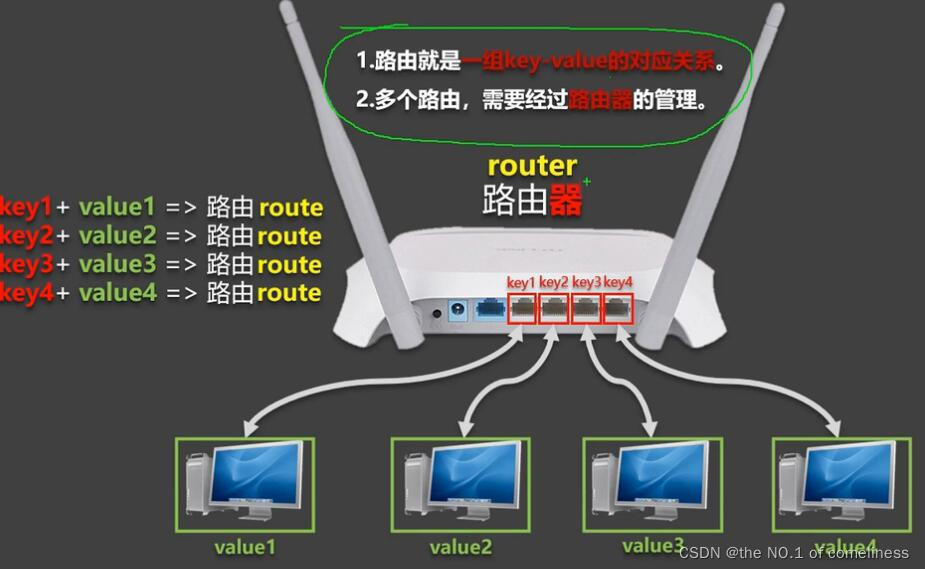
1、vue-router 的理解
vue 的一个插件库,专门用来实现 SPA 应用
2、对 SPA 应用的理解
- 单页 Web 应用(single page web application,SPA)。
- 整个应用只有一个完整的页面。
- 点击页面中的导航链接不会刷新页面,只会做页面的局部更新。
- 数据需要通过 ajax 请求获取


3、路由的理解
(1)什么是路由?
1. 一个路由就是一组映射关系(key - value)
2. key 为路径, value 可能是 function 或 component
(2)路由分类
- 后端路由:
1) 理解:value 是 function, 用于处理客户端提交的请求。
2) 工作过程:服务器接收到一个请求时, 根据请求路径找到匹配的函数 来处理请求, 返回响应数据。 - 前端路由:
1) 理解:value 是 component,用于展示页面内容。
2) 工作过程:当浏览器的路径改变时, 对应的组件就会显示。
(3)总结
1)一个路由(route)就是一组映射关系(key - value),多个路由需要路由器(router)进行管理。
2)前端路由:key是路径,value是组件。
基本使用
1、安装vue-router,命令:npm i vue-router
注意:
vue-router 4 只能在 vue3 中使用;vue-router 3 才能在 vue2中使用
因此,如果在vue2中安装,需要这样写:npm i vue-router@3
2、应用插件:Vue.use(VueRouter)
3、编写router配置项: 创建 src/router/index.js
// 该文件用于创建整个应用的路由器
import VueRouter from 'vue-router'
// 引入组件
import About from '../components/About'
import Home from '../components/Home'
// 创建并暴露一个路由器
export default new VueRouter({
routes:[
{
path:'/about',
component:About
},
{
path:'/home',
component:Home
}
]
})
4、在main.js 中引入
// 引入vue
import Vue from 'vue'
// 引入App
import App from './App.vue'
// 引入VueRouter
import VueRouter from 'vue-router'
// 引入路由器
import router from './router'
// 关闭生产提示
Vue.config.productionTip = false
// 使用插件
Vue.use(VueRouter)
// 创建vm
new Vue({
el:'#app',
render: h => h(App),
router:router
})
配置好路由器之后,地址栏会显示#

5、实现切换(active-class可配置选中时的高亮样式)
<router-link active-class="active" to="/about">About</router-link>
6、指定展示位置
<router-view></router-view>
案例的几个注意点

(1)
靠路由器规则,由路由器渲染出来的组件称为 路由组件。这里的Home.vue,About.vue。
通过<Banner/>来使用的组件,称为 一般组件
为了区分它们:
- src/pages 一般用来放 路由组件 (别忘了修改 src/router/index.js中的路径)
- src/components 一般用来放 一般组件
(2)当 从 Home 切换到 About, Home组件去哪里了?
Home组件会被销毁
(3)在Home组件中输出this,发现Home的vc身上多了两个属性

总结:
- 路由组件通常存放在pages文件夹,一般组件通常存放在components文件夹。
- 通过切换,“隐藏”了的路由组件,默认是被销毁掉的,需要的时候再去挂载。
- 每个组件都有自己的
$route属性,里面存储着自己的路由信息。 - 整个应用只有一个
router(路由器),可以通过组件的$router属性获取到。(每个组件上的$router属性是完全相同的)
嵌套(多级)路由
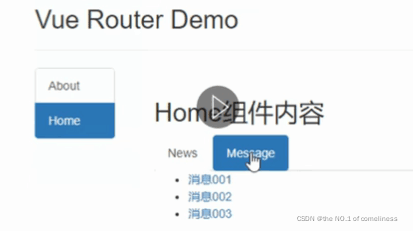
1、配置路由规则,使用children配置项:
routes:[
{
path:'/about',
component:About,
},
{
path:'/home', //这里的home 相当于一级路由
component:Home,
children:[ //通过children配置子级路由
{
path:'news', //此处一定不要写:/news
component:News
},
{
path:'message',//此处一定不要写:/message
component:Message
}
]
}
]
注意!!
配置children的 path时,,一定不要加 斜杠 /
不要忘记在 上面 引入 相关的组件
2、跳转(要写完整路径):
<router-link to="/home/news">News</router-link>
路由的query参数
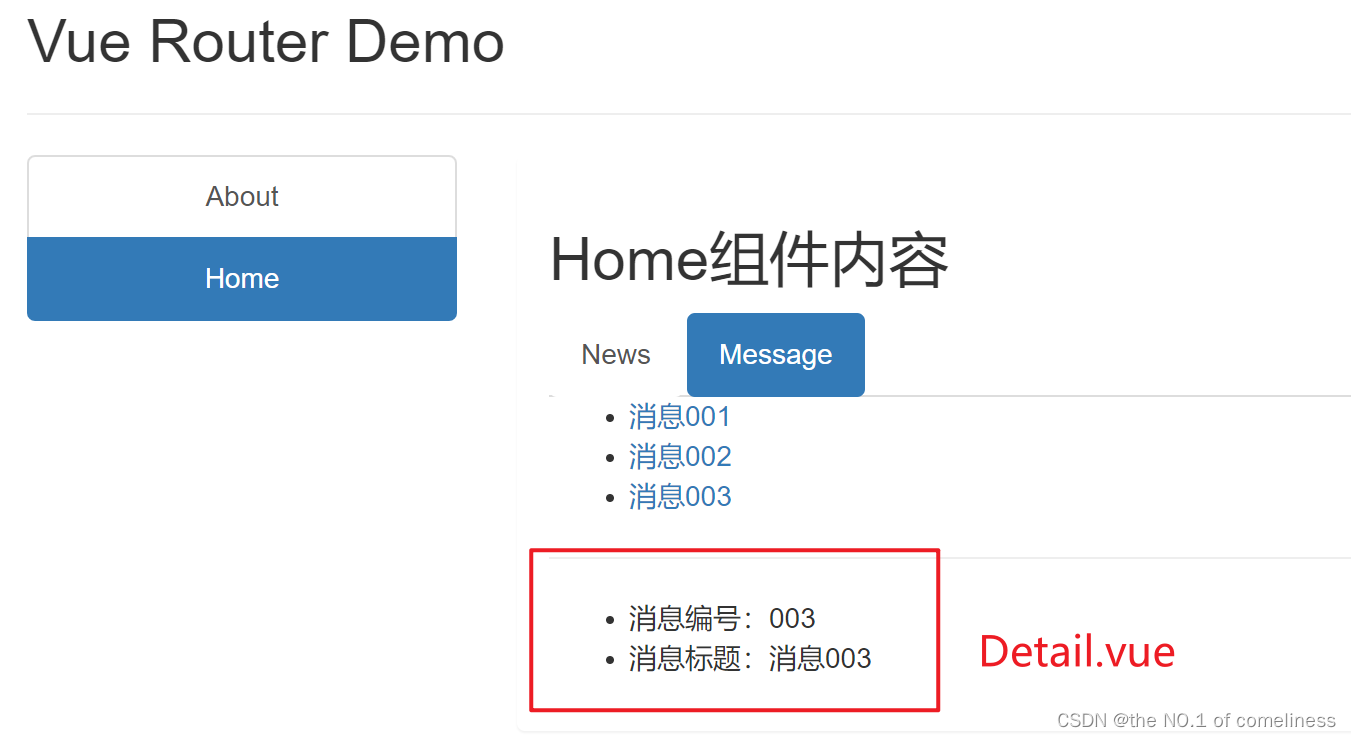
1、传递参数
(推荐使用对象写法)
<!-- 跳转并携带query参数,to的字符串写法 -->
<router-link :to="`/home/message/detail?id=${m.id}&title=${m.title}`">跳转</router-link>
<!-- 跳转并携带query参数,to的对象写法 -->
<router-link
:to="{
path:'/home/message/detail',
query:{
id:m.id,
title:m.title
}
}"
>跳转</router-link>
补充:在字符串写法中
:to="`/home/message/detail?id=${m.id}&title=${m.title}`"
- to 前面加 冒号: 表示要把后面当成 js表达式 解析
- 而使用模板字符串之后 ``,表明是 字符串
- 在模板字符串中,可以使用 ${xxx}的 形式引用变量
2、接收参数:
$route.query.id
$route.query.title
命名路由
1、作用:可以简化路由的跳转。
2、使用方式:
(1)给路由命名:
{
path:'/demo',
component:Demo,
children:[
{
path:'test',
component:Test,
children:[
{
name:'hello' //给路由命名
path:'welcome',
component:Hello,
}
]
}
]
}
(2)简化跳转:
<!--简化前,需要写完整的路径 -->
<router-link to="/demo/test/welcome">跳转</router-link>
<!--简化后,直接通过名字跳转 -->
<router-link :to="{name:'hello'}">跳转</router-link>
<!--简化写法配合传递参数 -->
<router-link
:to="{
name:'hello',
//简化前 path:'/demo/test/welcome',
query:{
id:666,
title:'你好'
}
}"
>跳转</router-link>
路由中的params参数
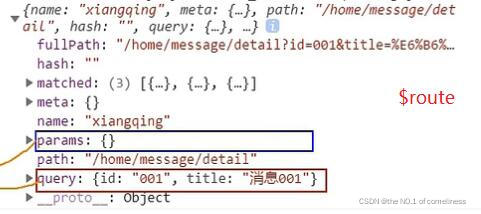
1、配置路由,声明接收params参数
{
path:'/home',
component:Home,
children:[
{
path:'news',
component:News
},
{
component:Message,
children:[
{
name:'xiangqing',
path:'detail/:id/:title', //使用占位符声明接收params参数
component:Detail
}
]
}
]
}
2、传递参数
<!-- 跳转并携带params参数,to的字符串写法 -->
<router-link :to="/home/message/detail/666/你好">跳转</router-link>
<!-- 跳转并携带params参数,to的对象写法 -->
<router-link
:to="{
name:'xiangqing', //必须用name
params:{
id:666,
title:'你好'
}
}"
>跳转</router-link>
特别注意:
路由携带params参数时,若使用to的对象写法,则不能使用path配置项,必须使用name配置!
3、接收参数:
$route.params.id
$route.params.title
路由的props配置
1、作用:让路由组件更方便的收到参数
2、使用方式
在index.js 中配置props
{
name:'xiangqing',
path:'detail',
component:Detail,
//第一种写法:props值为对象,该对象中所有的key-value的组合最终都会通过props传给Detail组件
// props:{a:900}
//第二种写法:props值为布尔值,布尔值为true,则把路由收到的所有params参数通过props传给Detail组件(只适用于 params)
// props:true
//第三种写法:props值为函数,该函数返回的对象中每一组key-value都会通过props传给Detail组件
props($route){
return {
id:$route.query.id,
title:route.query.title
}
}
//解构赋值的方式
// props({query}){
// return {id:query.id,title:query.title}
// }
//连续解构赋值的方式
// props({query:{id,title}}){
// return {id,title}
// }
}
在组件中接收:
props:['id','title']
路由对历史记录的影响
1、默认 是 push的模式
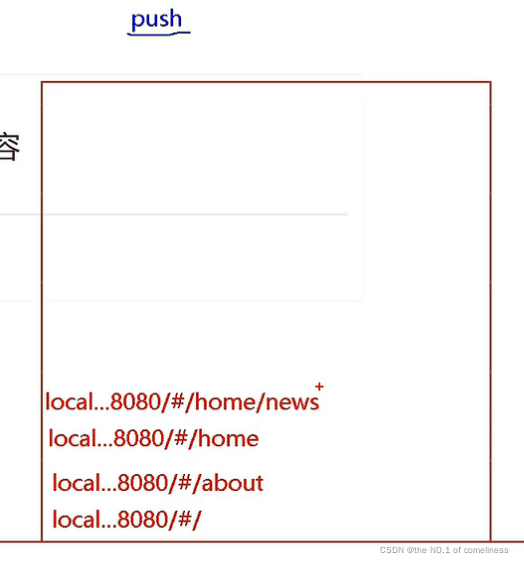
浏览器以压栈的形式,逐条的存放历史数据。可以前进也可以后退
2、可以更改成 replace 模式,新的替代旧的
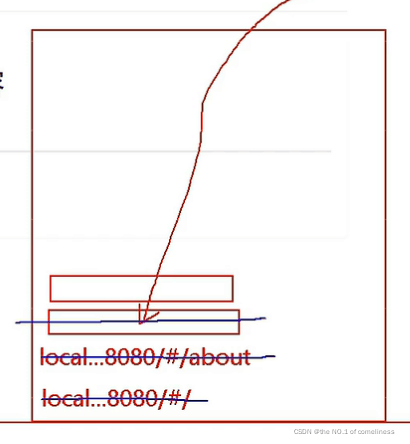
可以为路由开启 replace模式,在<router-link>标签中
<router-link :repalce="true" class="list-group-item" active-class="active" to="/home">Home</router-link>
//简写
<router-link repalce class="list-group-item" active-class="active" to="/home">Home</router-link>
3、总结
<router-link>的replace属性
(1)作用:控制路由跳转时操作浏览器历史记录的模式
(2)浏览器的历史记录有两种写入方式:分别为push和replace,push是追加历史记录,replace是替换当前记录。路由跳转时候默认为push
(3)如何开启replace模式:<router-link replace .......>News</router-link>
(4)案例中,当为News和Messages开启了replace,并且按照 About-Home-News-Messages的次序点击时:历史记录的情况如图所示
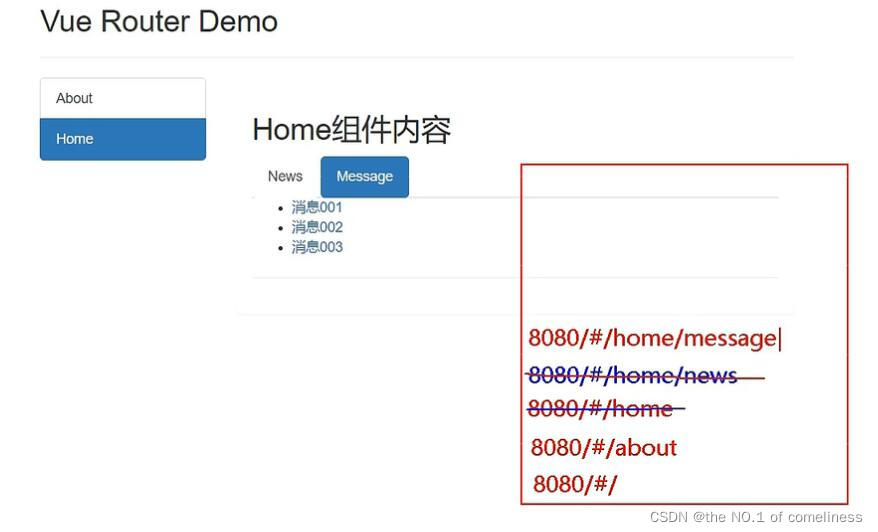
所以,当在message这个页面后退时,会退回到about那个页面
编程式路由导航
1、作用:不借助<router-link> 实现路由跳转,让路由跳转更加灵活
2、具体编码:
里面的内容和 <router-link> 的对象写法中的内容一致
//$router的两个API,使用push查看
this.$router.push({
name:'xiangqing',
params:{
id:xxx,
title:xxx
}
})
//使用replace 查看
this.$router.replace({
name:'xiangqing',
params:{
id:xxx,
title:xxx
}
})
this.$router.forward() //前进
this.$router.back() //后退
this.$router.go() //可前进(正数)也可后退(负数)。
this.$router.go(2)//前进两步
3、应用举例
<button @click="pushShow(message)">push查看</button>
<button @click="replaceShow(message)">replace查看</button>
<button @click="back">后退</button>
<button @click="forward">前进</button>
methods: {
pushShow(m){
this.$router.push({
name:'xiangqing',
query:{
id:m.id,
title:m.title
}
})
},
replaceShow(m){
this.$router.replace({
name:'xiangqing',
query:{
id:m.id,
title:m.title
}
})
},
back(){
this.$router.back()
},
forward(){
this.$router.forward()
}
},
缓存路由组件
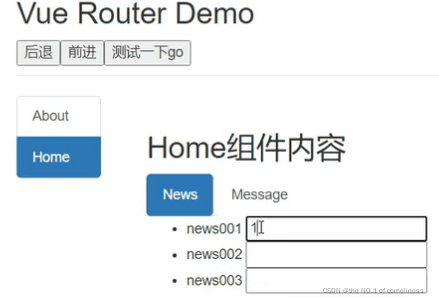
当在输入框输入东西后,切到message,再点回news,发现文本框中的内容没有了
因为 组件再被切换掉的时候,路由会被销毁
如何保存呢?
1、作用:让不展示的路由组件保持挂载,不被销毁。
2、具体编码:
include里面写 要缓存的组件名,如果不写默认全部的组件都要缓存
<keep-alive include="News">
<router-view></router-view>
</keep-alive>
//缓存多个组件
<keep-alive :include="['News','Message']">
<router-view></router-view>
</keep-alive>
注意:这里要判断 要缓存的那个组件在哪展示,在它展示地方的外面包上<keep-alive></keep-alive>
两个新的生命周期钩子
1、作用:路由组件所独有的两个钩子,用于捕获路由组件的激活状态。
2、具体名字:
- activated路由组件被激活时触发。
- deactivated路由组件失活时触发。
3、使用场景:
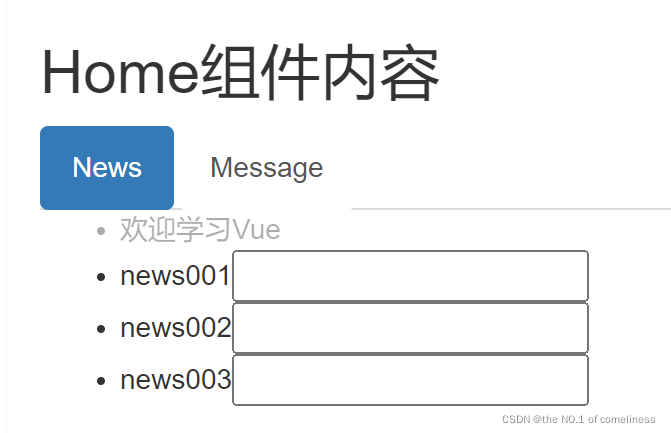
当使用如下代码实现 渐变效果时
<li :style="{opacity}">欢迎学习Vue</li>
data() {
return {
opacity:1
}
},
mounted(){
this.timer = setInterval(() => {
this.opacity -= 0.01
if(this.opacity <= 0) this.opacity = 1
},16)
},
beforeDestroy(){
clearInterval(this.timer)
},
从 News 切换到 Message ,定时器还会一直执行。
所以用这两个钩子就能很好地解决问题:
data() {
return {
opacity:1
}
},
activated() {
this.timer = setInterval(() => {
this.opacity -= 0.01
if(this.opacity <= 0) this.opacity = 1
},16)
},
deactivated(){
clearInterval(this.timer)
}
}
这样从News切换到其他组件时,定时器就会关闭。
4、补充:
在之前生命周期的学习中,除了图中的8个生命周期钩子。还有额外的3个钩子。
分别是 之前学到的 $nextTick ,和这里的 activated、deactivated
路由守卫
-
作用:对路由进行权限控制
-
分类:全局守卫、独享守卫、组件内守卫
1.、全局守卫
// 创建并暴露一个路由器
const router = new VueRouter({
routes:[
{
name:'guanyu',
path:'/about',
component:About,
meta:{title:'关于'}
},
{
name:'zhuye',
path:'/home',
component:Home,
meta:{title:'主页'},
children:[
{
name:'xinwen',
path:'news',
component:News,
meta:{isAuth:true,title:'新闻'}
},
{
name:'xiaoxi',
path:'message',
component:Message,
meta:{isAuth:true,title:'消息'},
children:[
{
name:'xiangqing',
path:'detail',
component:Detail,
meta:{title:'详情'},
props($route){
return {id:$route.query.id,title:$route.query.title}
}
}
]
},
]
}
]
})
//全局前置守卫:初始化时执行、每次路由切换前执行
router.beforeEach((to,from,next)=>{
console.log('beforeEach',to,from)
if(to.meta.isAuth){ //判断当前路由是否需要进行权限控制
if(localStorage.getItem('school') === 'atguigu'){ //权限控制的具体规则
next() //放行
}else{
alert('暂无权限查看')
// next({name:'guanyu'})
}
}else{
next() //放行
}
})
//全局后置守卫:初始化时执行、每次路由切换后执行
router.afterEach((to,from)=>{
console.log('afterEach',to,from)
if(to.meta.title){
document.title = to.meta.title //修改网页的title
}else{
document.title = 'vue_test'
}
})
export default router
注意:
(1)使用全局守卫就不能使用默认暴露了
(2)routes里面的每个对象 都有一个 meta 属性,可以用来自定义一些属性
(3)在修改网页标题是,使用后置守卫
2、独享守卫
某一个路由所独享的守卫。注意这里没有 after,只有before。可以和全局后置守卫搭配使用
{
name:'xinwen',
path:'news',
component:News,
meta:{isAuth:true,title:'新闻'},
beforeEnter: (to, from, next) => {
if(to.meta.isAuth){ //判断是否需要鉴权
if (localStorage.getItem('school') === 'atguigu') {
next()
}else{
alert('无权限查看')
}
}else{
next()
}
}
},
3、组件内守卫
在某个组件内写的,为某个组件配置的
//进入守卫:通过路由规则,进入该组件时被调用
beforeRouteEnter (to, from, next) {
},
//离开守卫:通过路由规则,离开该组件时被调用
beforeRouteLeave (to, from, next) {
}
注意:离开守卫与上面的全局后置守卫不同! 全局后置守卫 进入组件之后 会立即被调用
但这里的离开守卫,是在离开组件的时候才被调用
路由器的两种工作模式
1、对于一个url来说,什么是hash值?—— #及其后面的内容就是hash值。
2、hash值不会包含在 HTTP 请求中,即:hash值不会带给服务器。
3、hash模式:
- 地址中永远带着#号,不美观。
- 若以后将地址通过第三方手机app分享,若app校验严格,则地址会被标记为不合法。
- 兼容性较好。
4、history模式:
- 地址干净,美观 。
- 兼容性和hash模式相比略差。
- 应用部署上线时需要后端人员支持,解决刷新页面服务端404的问题。

这里的 # 称为 hash(哈希),#/home/message 称为哈希值,它不会随着http请求发给服务器
比如说,在地址栏加入哈希值之后:

访问到的还是 http://localhost:5000/students 这个页面,也就是说哈希值不会作为路径的一部分发给服务器
构建一个小型的服务器
1、关于打包
- 写好的项目需要进行打包,才能放到服务器上
- npm run build
- 打包完成后会生成dist文件夹
2、打包后要将其部署到服务器上才能访问
可以使用 node express 搭建一个服务器
(1)创建一个文件夹 demo,并用 vscode打开
(2)npm init – 输入名称
(3)安装express :npm i express
(4)在demo下新建一个服务器文件:server.js
// 引入express
const { response } = require('express')
const express = require('express')
const app =express()
app.get('/person',(req,res) => {
res.send({
name:'tom',
age:18
})
})
app.listen(5005,(err) => {
if(!err) console.log('服务器启动成功了')
})
(5)启动服务器: node server

(6)在demo下新建static文件夹,它一本用来存放 css,js和html文件。所以这里将 生成的dist文件下的内容 放到 static文件夹下
在server.js 中添加如下配置:
// 引入express
const { response } = require('express')
const express = require('express')
const app =express()
app.use(express.static(__dirname+'/static')) //这里!!!!
app.get('/person',(req,res) => {
res.send({
name:'tom',
age:18
})
})
app.listen(5005,(err) => {
if(!err) console.log('服务器启动成功了')
})
(7)server.js更改后需要重启服务器,关闭(Ctrl+c), 开启 node server
如果static下有 index.html,输入 http://localhost:5005/ 即可访问
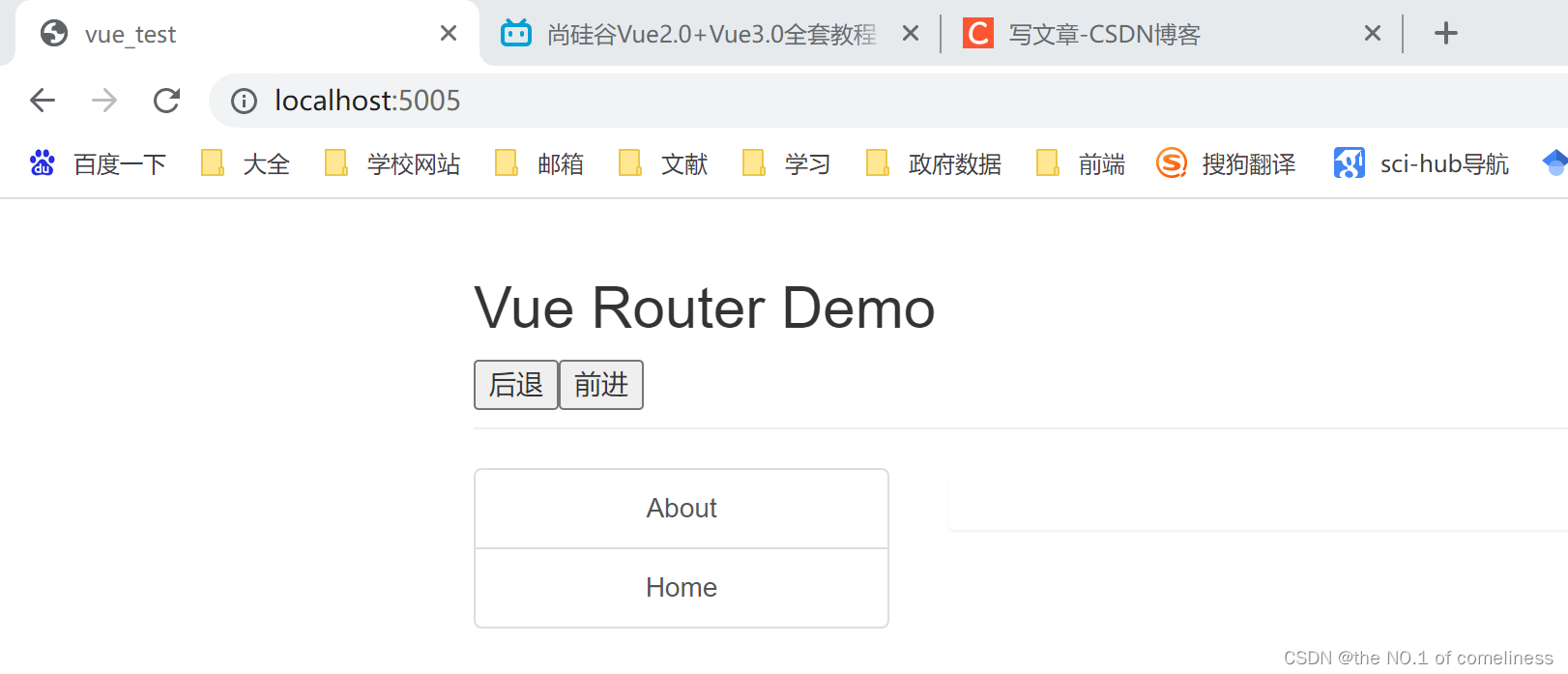
访问static下的其他文件,可以使用http://localhost:5005/xxx.html
注意:
- 在 history 模式下,当刷新页面时,就会发送网络请求,而服务器中并没有这个路径就会报错

- 而在 哈希模式下 不会出现这个问题,刷新也没事
- 但是在 实际工作中,还是常用 history 模式,因为路径比较美观。如何解决history的这一问题?
找后端工程师:
https://www.npmjs.com/package/connect-history-api-fallback
在server.js中:
安装:npm i connect-history-api-fallback
引入:const history = require(‘connect-history-api-fallback’);
使用:app.use(history()) //必须在引入静态资源前使用
// 引入express
const { response } = require('express')
var history = require('connect-history-api-fallback');
const express = require('express')
const app =express()
app.use(history())
app.use(express.static(__dirname+'/static'))
app.get('/person',(req,res) => {
res.send({
name:'tom',
age:18
})
})
app.listen(5005,(err) => {
if(!err) console.log('服务器启动成功了')
})
这样就可以解决404 的问题了























 被折叠的 条评论
为什么被折叠?
被折叠的 条评论
为什么被折叠?








